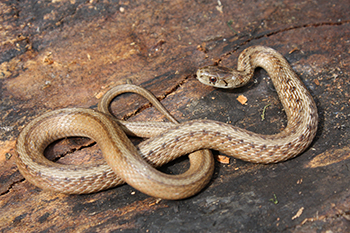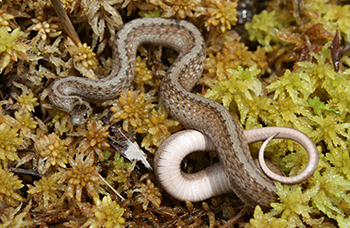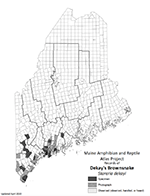Home → Fish & Wildlife → Wildlife → Species Information → Reptiles & Amphibians → DeKay’s Brownsnake
DeKay’s Brownsnake
Storeria dekayi
On this page:

Photo: Trevor Persons
Distinguishing Characteristics
- Small, approximately 9 to 14 inches in length
- Grayish-brown above, with two parallel rows of black dots along back
- Pale tan or light brown below
- Black vertical streak on side of head behind eye
- Dorsal scales keeled (longitudinal raised ridge along midline of each scale)
- Juveniles darker than adults with light band across neck, sometimes confused with young ring-necked snake and red-bellied snake
Status and Distribution in Maine
- State Special Concern; Species of Greatest Conservation Need
- Uncommon
- Southern and central regions
Habitat

Photo: Trevor Persons
- Found in forested uplands, brushy fields, and near bogs and marshes
- Often at home in suburban and even urban areas
- Commonly found under rocks, logs, boards, and debris piles
Diet
- Diet includes slugs, earthworms, insects, and small treefrogs and toads
Seasonal Changes
- Often hibernates in large aggregations underground; one researcher found 97 snakes within a single anthill. Also hibernates in stone walls, rock crevices, rodent burrows, and sawdust piles
Natural History Notes
- Gives birth to live young from mid-July through August
- Rarely bites when handled, but releases musky discharge
Share Your Sighting
There is much still to learn about the distribution and ecology of Maine’s herpetofauna, and we encourage members of the public to share their photo-documented observations as part of the Maine Amphibian & Reptile Atlas Project (MARAP).
To see if a township still needs documentation of a species, consult this distribution map (PDF). If a township lacks a photo or specimen record, we want your observation!
There are two ways to share your observations:
Submit your reptile or amphibian observation online
No service? No problem. Click here to download the survey to your device while connected, then take offline to collect observations from anywhere. Tip: The survey works best on Google Chrome and Safari.
Or upload sightings to the iNaturalist citizen science project through their website at iNaturalist.org or mobile app.
- When submitting an observation through iNaturalist add a description of the location (and other noteworthy information) to the “notes” field. This serves as a check on the locations automatically generated by smartphone cameras, which may be imprecise if cell service or GPS coverage is weak.
Thank you for doing your part to help conserve Maine’s reptiles and amphibians.
